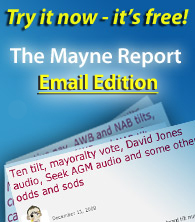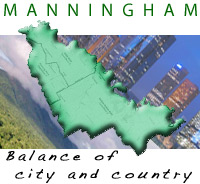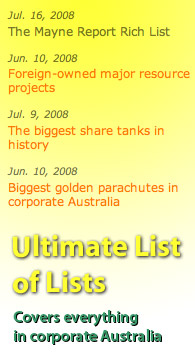Murdoch, People Power, AWA debate
July 22, 2008
Here are Stephen Mayne's three stories from the Crikey edition on Friday, 30 June, 2006.
12. The Murdochs and the Baillieus – a family history
By Stephen Mayne, former resident of Murdoch Street in Camberwell
Having finished his duties in Sydney with yesterday's presentation to analysts and fund managers, Rupert Murdoch has returned to the city of his birth, Melbourne, to catch up with his mother, sisters, loyal Herald Sun workers and maybe a politician or two.
When he visits Dame Elisabeth at Cruden Farm in Narre Warren, the topic could well turn to the forthcoming Victorian election and that very old money Melbourne family that goes so far back with the Murdochs – the Baillieus.
Ronald Younger's Keith Murdoch: Founder of a Media Empire mentions the Baillieu family on 26 different pages including the following about the late 1800s in Melbourne:
By chance, at the same time as Patrick Murdoch (Rupert's grandfather) began ministering to Prospect Hill parishioners, the Camberwell area was receiving attention from William Lawrence Baillieu, a dynamic land salesman who had recently arrived in Melbourne after successful business ventures in the colony's gold-mining centre of Castlemaine ... Baillieu established his residence, Heathfield, on the crest of Prospect Hill Road half a dozen blocks from where the Murdoch family lived.All of this begs the question as to how close the two families are today and whether close family histories will count for anything in the forthcoming Victorian election campaign. Don't be surprised if Rupert catches up with both Premier Steve Bracks and new opposition Ted Baillieu while visiting Melbourne, as he usually likes to personally size up the talent before an election.
During the Prospect Hill years Baillieu and the Reverend Murdoch found common ground in something of an obsession with the game of golf. Clive Baillieu, eldest of the Baillieu children, and three years younger than Keith, joined the Fairholme boys in 1895. He was a natural leader and later became captain of the school; the friendship that developed between the son of the business tycoon and the son of the clergyman was to endure in coming years as each made his way to notable success in the world.
Rupert's family are certainly up to their ears in Liberal politics and in a position to influence Victorian politics in a major way through the world's highest penetration newspaper, the Herald Sun, and more than 100 local and regional papers across the state. Dame Elisabeth traditionally displays Liberal posters on Cruden Farm during elections, her daughter Janet Calvert-Jones chairs the Herald & Weekly Times board and, most importantly, Rupert's brother-in-law John Calvert-Jones is Federal Treasurer of the Liberal Party.
So here we have the most powerful media outlet in Victoria chaired by the sister of the man responsible for funding the Liberal campaign and led by someone who is an old family friend of the Murdochs. The Bracks Government will almost certainly win comfortably, but don't be surprised if the Herald Sun gets right behind Ted Baillieu, provided he scrubs up as a credible alternative premier.
14. Laying down the ground rules in covering People Power
By Stephen Mayne, constantly campaign immersed journalist
Today's feedback section carries a strong letter from Nicola Paris pointing out my conflict of interest in writing about People Power's campaign to win the balance of power in Victoria's new upper house, especially yesterday's link to the start-up party's donations page. She's right on this last point, so we've decided to lay down some grounds for the next five months.
I'll be devoting about half my time to People Power up until polling day on 25 November, but much of that will be spent gathering information about Victorian politics and disseminating it. There will be two vehicles – Crikey for brief but worthy news and commentary and a regular and free People Power email newsletter which will contain more information on the Victorian campaign than you will find anywhere else.
Crikey subscribers who are interested in all the fine detail of our campaign and Victorian politics generally can sign up to the People Power newsletter on the home page. This is partly copying the jeffed.com model from 1999 – if you can't get your message out through the mainstream media, build your own outlet with compelling content and they will come. Jeffed attracted more traffic than the ALP site during the final week of the 1999 campaign and was widely credited with helping bring down Jeff Kennett.
However, to ban me from writing about the forthcoming Victorian campaign on Crikey would be to abandon a practice that has been part of this ezine since in was launched on 14 February, 2000. It's called immersion journalism and this involves blending activism and journalism by directly becoming involved with a story and then writing about the experience.
We've literally published millions of words about my previous 28 tilts, so why stop now? As has happened before, the likes of Charles Richardson and Christian Kerr will be perfectly free to rubbish People Power's policies and prospects on Crikey. Subscribers and rival parties are free to sledge away in our feedback section.
When you run for office you learn a whole lot more about an issue than if you just remain on the sidelines as some independent journalistic observer. It's the same with investments - when you're a shareholder you take a greater interest. This insight will generate some unique content for Crikey. Sure, no mainstream media outlet would do that, but this practice is one of the things which makes Crikey unique.
As long as the conflict is declared, there isn't a problem. But you won't see any more links to People Power's donations page or clarion calls for Crikey readers to sign up as members of candidates. All that sort of guff will be part of the mix in the People Power newsletters.
24. Woodside, Gary Gray and the AWA debate
By Stephen Mayne, who quit the MEAA and signed a no-strike contract with Rupert on the Herald Sun in 1994
John Howard claims that abandoning AWAs is a "dagger to the throat" of Australia's resources industry. But there are two commodities that are leading the charge in the great Australian resources boom of 2005-06 – iron ore and coal – and each features starkly different IR arrangements.
True, the iron ore industry in the Pilbara has embraced AWAs, partly because the turf wars between unions led to many frustrating interruptions to the income flows to workers, as Matthew Stevens explains in The Australian today. However, the coal industry is booming just like iron-ore and you don't see any AWAs in these mines because the CFMEU is strongest in the coal industry where collective agreements prevail.
John Howard is clearly not having a good run with his commercial and political dealings over Woodside Petroleum. First we had the hard yards he put in to get those 25-year LNG contracts signed three years ago – deals which have now cost North West Shelf shareholders billions of dollars because prices have since taken off.
The PM then went to China to greet the first LNG shipment arriving and blundered in claiming Woodside was AWA dependent. The Australian captured the debate with this story and The AFR also carried a page seven lead headlined "Woodside dents PM's IR attack".
The senior people at Woodside are an interesting combination. Chairman Charles Goode is a Liberal Party stalwart who chairs one of its Victorian fundraising arms. However, former ALP national secretary Gary Gray is the company's director of corporate affairs. Was it Gary who created all those headlines today by pointing out that Woodside's 3,200 permanent staff working on the North West Shelf are on common law contracts, not AWAs?
Copyright © 2024 The Mayne Report. All rights reserved






















